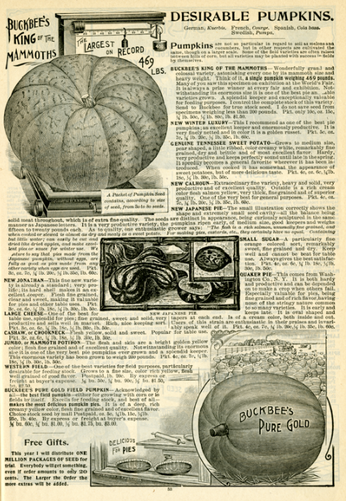|
“Desirable Pumpkins,” H.W. Buckbee Seed and Plant Guide (Rockford, IL, 1899). Special Collections, National Agricultural Library.
|
Desirable Pumpkins
By the end of the nineteenth century, Americans used pumpkins mainly for pleasure, not for practicality. It became an object of display. Giant pumpkins were crowd-pleasers at county fairs, which became known as “Pumpkin Shows,” because the vegetable was a key attraction. Buckbee’s seed company called its “King of the Mammoth,” a 469-pounder exhibited at the 1893 World’s Fair, a “wonderfully grand and colossal variety, astonishing everyone by its mammoth size and heavy weight.” Merchants put them in their shop windows. Its popularity for dessert and display began to stir demand for this once-worthless crop and, by extension, profits for farmers.
|

|
|
- Home
- About the Book
- About the Author
-
Online Exhibition
- Just Another Squash: 12,000 BCE to 1600
- From Pumpkin Beer to Pumpkin Pie: 1600 to 1799
- The Making of a Rural New England Icon: 1800 to 1860
- The Pumpkin and the Nation: 1861 to 1899
- Americans Celebrate the Fall Harvest with Pumpkins: 1900 to 1945
- The Changing Nature of Pumpkins: 1946 to the Present
- The Changing Nature of American Rural Economies: 1946 to the Present
- Events
- Contact

